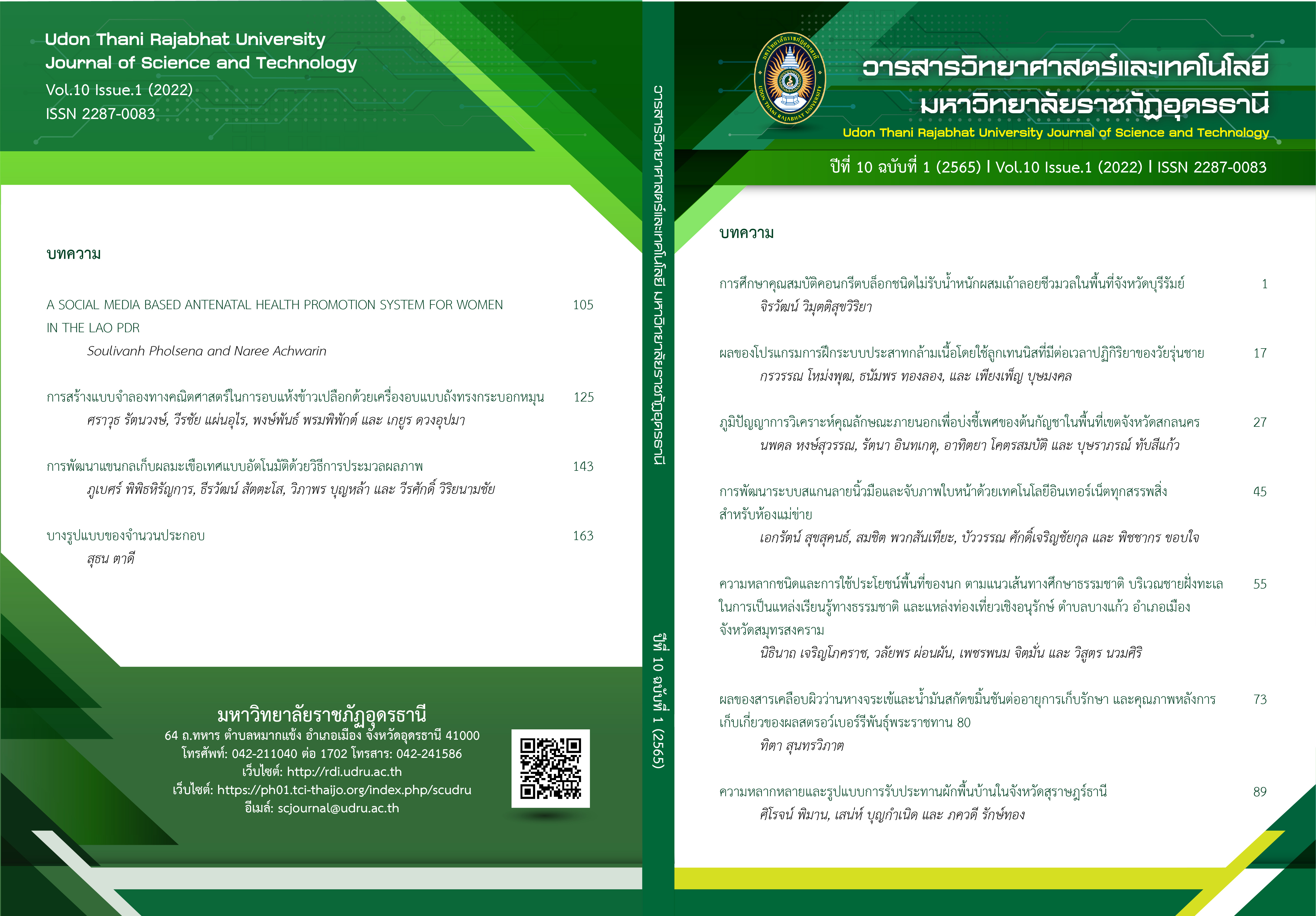MATHEMATICAL MODELING FOR PADDY DRYING BY ROTARY DRIER
Main Article Content
Abstract
Thailand has produced rice for consumption as the main food and an important export product. Highly qualified rice production was obtained from caring as growing and prolongation after rice harvest with the appropriate procedure. This research aimed to present drying techniques to help in paddy prolongation after harvest. The procedure began by drying rice cultivars KDML105 with hot air in a rotary dryer within 90 min to study 3-level results of drying temperature at 80°C, 100°C and 120°C affecting the moisture of paddy. The results of the experiment were compared with analysis by mathematical model of empirical drying equation. The research results were found that high drying temperature reduced moisture and moisture ratio as an exponential function curve. The appropriate mathematical model of the drying equation was Page's drying equation because the paddy moisture change prediction was high at 0.9949-0.9977 and the low RMSE value was at 0.0110-0.0139 which was most similar to the results of the experiment. The effective moisture diffusivities were found that increasing the drying temperature would accelerate the evaporation of water at the surface of paddy resulting in higher effective moisture diffusivities. Furthermore, this research can be applied to estimate the results obtained for the drying process for agricultural products that require a high drying temperature, such as chili, longan and legumes, etc.
Article Details
References
กิตติ สถาพรประสาธน์ และ โพธิ์ทอง ประณีตพลกรัง. (2560). แบบจำลองทางคณิตศาสตร์ในการอบแห้งข้าวเปลือกด้วยเครื่องอบแห้งแบบเจ็ตสเปาต์เต็ดเบด. วิศวสารลาดกระบัง, 34(4), 22-29.
ทรงพล วิจารณ์จักร, สุพรรณ ยั่งยืน และ จักรมาส เลาหวณิช. (2560). การศึกษาความเป็นไปได้ในการใช้เครื่องอบแห้งแบบถังทรงกระบอกหมุนด้วยรังสีอินฟราเรดร่วมลมร้อนปล่อยทิ้งในกระบวนการผลิตข้าวกล้องงอก. วารสารวิทยาศาสตร์เกษตร, 48(3), 51-54.
ธนากรณ์ อุ่นพินิจ, วรินรำไพ เศรษฐ์ธนณบุตร, ทินกร คำแสน, พนมกร ขวาของ และ อภิชาติ อาจนาเสียว. (2560). การลดความชื้นข้าวเปลือกด้วยคลื่นไมโครเวฟแบบอัตโนมัติ. วิศวกรรมสารเกษมบัณฑิต, 7(1), 124-139.
ธัชพล จุ้งเจริญ, การันต์ ดวงนิราส, วัชระ วงศ์สุกรี และ อนุพงศ์ มีโคตรกอง. (2560). ผลของความชื้นเริ่มต้นและความสูงเบดของข้าวเปลือกต่อความเร็วลมต่ำสุดในเครื่องทดสอบการเกิดฟลูอิไดเซชัน. น. 255-264. ใน: การประชุม การประชุมวิชาการระดับชาติ มหาวิทยาลัยรังสิต ประจำปี 2560. 20 เมษายา 2560. มหาวิทยาลัยรังสิต, กรุงเทพฯ.
ปรีดา ปรากฎมาก. (2559). แบบจำลองการถ่ายเทมวลสารและการเปลี่ยนแปลงทางกลของเมล็ดข้าวระหว่างการอบแห้งแบบฟลูอิไดซ์เบด. วิศวสารลาดกระบัง, 33(2), 42-48.
พระราชบัญญัติ มาตรฐานสินค้าเกษตร พ.ศ. 2551. (2560, 8 กันยายน). ราชกิจจานุเบกษา. เล่มที่ 134 ตอนพิเศษ 221 ง, หน้า 42.
พิศมาส หวังดี. (2558). คุณสมบัติทางกายภาพของข้าวเปลือกและข้าวเปลือกนึ่ง. วารสารวิจัย มหาวิทยาลัยเทคโนโลยีราชมงคลตะวันออก, 8(1), 23-28.
โพธิ์ทอง ปราณีตพลกรัง และ กิตติ สถาพรประสาธน์. (2560). การประยุกต์ใช้เทคนิคเจ็ต สเปาต์เต็ดเบดร่วมกับคลื่นอัลตร้าซาวด์สำหรับอบแห้งผลผลิตทางการเกษตร. วารสารวิศวกรรมศาสตร์ มหาวิทยาลัยศรีนครินทรวิโรฒ, 12(1), 163-175.
ละมุล วิเศษ. (2555). ปัจจัยที่ส่งผลกระทบต่อคุณภาพด้านการหุงต้มของข้าว. วารสารวิทยาศาสตร์บูรพา, 17(1), 172-180.
สมพจน์ คำแก้ว. (2564). อุณหภูมิการอบแห้งแบบหมุนเวียนของข้าวเปลือกมีผลต่อสารหอม (2AP). วารสารวิศวกรรมศาสตร์ มหาวิทยาลัยศรีนครินทรวิโรฒ, 16(3), 1-9.
สุชีวา สิทธิจินดา, คงฤทธิ์ รีวงษ์ และ ธราธิป ภู่ระหงษ์. (2559). การพัฒนาเครื่องไล่ความชื้นข้าวเปลือกในครัวเรือนควบคุมอัตโนมัติด้วยไมโครคอนโทรลเลอร์ Arduino. น. 436-443. ใน: การประชุม การประชุมวิชาการระดับชาติ มหาวิทยาลัยราชภัฏกำแพงเพชร ครั้งที่ 3. 22 ธันวาคม 2559. มหาวิทยาลัยราชภัฏกำแพงเพชร, กำแพงเพชร.
อีลีหย๊ะ สนิโซ, ฟามีรา สะอุดี และ รัชดาภรณ์ ฮานาฟี. (2555). สัมประสิทธิ์การแพร่ความชื้น ความสิ้นเปลืองพลังงาน และอัตราการระเหยน้ำจำเพาะของการอบแห้งผลหมากด้วยพลังงานความร้อนร่วม. วารสารวิทยาศาสตร์บูรพา, 17(1), 142-149.
Ademiluyi, F. T., & Abowei, M. F. N. (2013). Theoretical model for predicting moisture ratio during drying of spherical particles in a rotary dryer. Hindawi Publishing Corporation Modelling and Simulation in Engineering, Retrieved from https://doi.org/10.1155/2013/491843.
Association of Official Analytical Chemists. (1995). Official Methods of Analysis of the Association of Official Analytical Chemists. Washington D.C., USA.
Aviara, N. A., & Igbeka, J. C. (2016). Modeling for drying of thin layer of native cassava starch in tray dryer. Journal of Biosystems Engineering, 41(4), 342-356.
Chakraborty, S., Sarma, M., Bora, J., Faisal, S., & Hazarika, M. K. (2016). Generalization of drying kinetics during thin layer drying of paddy. Agricultural Engineering International, 18(4), 177-189.


